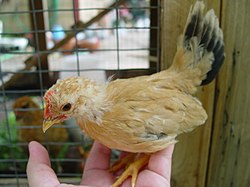Japanese Bantam

The Japanese Bantam, also known in many parts of the world as Chabo, is a breed of chicken originating in Japan. They are a bantam breed, with large upright tails that often reach over the chicken's head. The wings angle down and to the back along the sides.
History
This little chicken has graced the gardens of the Japanese aristocracy for well over 350 years. Historical evidence suggests that the Japanese Bantam originated in Southeast Asia, where it is still raised today. They enjoy a high degree of popularity in Malaysia, and are very common in Java, which is now part of Indonesia.
Japanese Bantams began to appear in Japanese art around the year 1635, right about the time Japan closed its shores to outside trade. It also appears in Dutch art of the same era. This suggests that Dutch spice traders probably carried the Chabo as gifts to the Japanese from the Asian spice ports, such as Hoi An (Vietnam) and likely from Java, which part of Dutch colonial area on that time. The very word "chabo" originates in Java as chabol (Cebol) , where it means "dwarf" and applies both to humans, and to the short-legged Chabo chicken. In Japan, the word would drop the "L," as no speaker of Japanese would be inclined to pronounce it.
Characteristics
They have wonderful personalities, and will gladly ride around on your shoulder or be petted and held. Japanese Bantams are also good foragers, and will pretty much feed themselves if they have a large enough area to do so.
Variations

There are different kinds of Japanese Bantams which include Black-Tailed-White, White, Buff, Black-Tailed-Buff, Gray, Blue, Barred, Black Breasted Red, Black, and many more. These are usually referred to BTW, BTB, etc. These chickens have been known to live for up to 13 years with proper care. As with most other chickens, even though the birds are very docile and friendly, do not put too many males together or they will fight.
Genetics
One unusual characteristic of Japanese bantams is extremely short legs. The trait is mainly caused by a single lethal gene, and all Japanese bantams are heterozygous. When the bantams are bred, 25% of the embryos receive two mutant alleles and die before hatching. 50% of the embryos receive one mutant allele and one wild type allele and are short-legged. The remaining 25% receive two wild type alleles and have legs that are longer than what most breeders want. When the long-legged birds are bred together, they never produce offspring with short legs.
References
- "Ohio National Articles". Ohio National Articles.
- "Japanese Bantams Article". About Japanese Bantams.
- "Japanese Bantams Main Page". Central Pets's Japanese Bantams Article.
